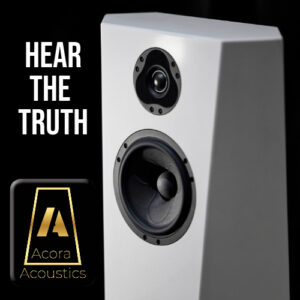There is a picture of Big Ben that every tourist in London takes, just opposite the South Bank Lion in front of the St. Thomas’ Hospital Stop D. The shot is a scenic photo of Big Ben along with the Westminster Bridge, and just before the steps leading down to the riverwalk is always crowded with iPhones vying for the best spot. It’s also the very worst place to take the picture.
Walk just a few steps down to the actual riverwalk, or to the north side of the bridge, and you’ll get a far better angle, especially during sunset; plus you’ll miss the dozens of posing tourists waiting their turn. The lesson here is, as Robert Frost once put it, the road less traveled has made all the difference.
Scene change: Long Valley, New Jersey, a tranquil enclave an hour west of New York City. A Dutchman, a Brit, and an American walk into a hi-fi shop. Except it isn’t really a hi-fi shop as you’d traditionally think of it, but a temple to music, within which everything has been curated with the idea that the road less traveled is very much worth the journey.
Here I spent two of the most delightful days of my hi-fi career communing with speakers and people that have chosen to do things on their own terms. Courtesy of the incredibly gracious Bill Parish and Dick Diamond of GTT Audio, the opportunity to listen to Laurence Dickie and his newest creation—Vivid Audio‘s flagship Moya—was a rare pleasure.
Words and Photos by Grover Neville

Vivid Audio
The first day began with some presentations by Ewald Verkerk, the brand manager and chief evangelist of Vivid, followed by Laurence Dickie himself giving us insight into the Vivid speakers. There are some novel technologies used in the construction of Vivid speakers that no other manufacturer I am aware of implements.
The primary and most noticeable among these are the glass composite cabinets, which, while quite stiff, are actually fairly light compared to the heavily mass-damped cabinets of many other manufacturers. The G4 Series 2 I reviewed could be lifted easily with one hand—a refreshing change from the massive and challenging loads of other high-end speakers.
The reason these cabinets work is also partially due to the internal structure, which decouples the drivers from the cabinet. The drivers float, in a sense, unimpeded by the vibrations of the cabinet, and a finger on the cabinet will reveal a startlingly inert feeling. Even at full blast, the cabinet is eerily vibration-free in a way that is hard to communicate in words.
Those same beautifully organic cabinets also serve two other purposes—minimizing the baffle interactions with a smooth surface, as well as containing the resonance-damping Tapered Tube Loading system and a sort of Helmholtz resonator that Laurence Dickie and Ewald demonstrated for us. These and the other unique Vivid technologies add up to a speaker which has a distinctly different sound than what has been mainstream in high-end loudspeakers for some time.
Moya’s Invisible Sound
In contrast to a modern trend for a somewhat overdamped alignment in modern speakers, which tends to result in a drier, more analytical sound, the Vivid line—and most of all the Moya—opt for a sound I would describe as much closer to invisible. Sounds from the Moya emerge from empty space and create more of that lucid-dreaming “the sound is detached from the speakers” sensation hi-fi enthusiasts crave.
Perhaps most of all, though, Vivid speakers, and particularly the Moya, make you realize just how many resonances, cabinet vibrations, and other distortions you’re hearing with other speakers. There is a total lack of the sense of a box sound even well-damped boxes have, replaced instead by a liquid-smooth midrange and a sound I can only describe as drivers floating in space.
Add to this the fact that the Moya has none of the clinical coldness or steel often mistaken for good low-level detail retrieval, and you have instead a seductive and wide presentation which takes the focus off the speakers and puts it squarely back on the music—dare I say this is closer to that famous transparency we audiophiles are always chasing?

The Road Less Traveled
The road less traveled approach clearly works in favor of Mr. Dickie’s approach here, and was perhaps no better demonstrated by my experience listening to Robert Spano and the Atlanta Symphony’s recording of the premiere of Christopher Theofanidis’s *Rainbow Body*, a piece inspired by Hildegard von Bingen’s Ave Maria. I’ve always thought this a nice recording of wonderful music, with middling sound quality. At a pivotal crescendo, however, rather than folding inward and getting congested, the Moya instead exploded outward and enveloped Bill Parish’s enormous room with a scale that was astonishing. It’s rare that I hear something new in a recording I know well—even rarer that a massive, aspirationally priced speaker like the Moya reveals something new to me in a way that is also flattering to the music. Yet everything the Moya did uplifted the music and gave me insight that also enhanced my enjoyment.
While the Moya undoubtedly has the house sound, I did take a listen to the G1 Spirit and a few other Vivids around GTT during the two days. The Moyas, by far, had the most astonishing soundstage scale and low-end power. No matter the speaker, that seductive, invisible, and liquid sound was maintained, but in the new flagship it was able to breathe on an even larger scale. This is the heady stuff that Summit-Fi is made of, and the Moya attained heights comparable to the very best of what I’ve heard from Tidal and TAD.

Behind the Sound: Vivid and GTT
What was less heady was the wonderful company, and it cannot be overstated that the personnel at Vivid and GTT make the idea of a purchase more of the warm and fuzzy than the transactional variety. From hearing Ewald hold court on being snuck into the King of Denmark’s seats at the Concertgebouw, to experiencing Nicki Minaj performing virtual duets, to witnessing Laurence Dickie finger-drumming on a table to Lucinda Williams while analyzing CAD files, there is an indescribable something quirky yet human about Vivid Audio. The people are as unique as the speakers, and while I frequently reserve my unfiltered commentary for non-audio spaces, I felt as at home with Bill, Dick, and the team at Vivid as I feel with any of my non-audio community. They are the kind of people that make purchasing and listening to music as fun as it should be.
The path less traveled requires this team, a team which is willing to try the novel, the unexpected, and even the risky. I came away impressed however at the judiciousness of the team—make no mistake, for all the joviality and fun, these people are experts in their field. From Laurence Dickie’s exceptional technical knowledge and engineering-based designs, to Ewald’s masterful presentations, and Bill Parish’s wealth of knowledge and system setup skills—seriously, this guy has at least seven rooms and they all sounded spectacular—I felt I was in the presence of the highest caliber of people. Bill Parish at one point expressed his interest in classical music, and that “I’ll spend a year or two on Lieder, then chamber, the Second Viennese School, and so on…” and my jaw about hit the floor. The level of open-mindedness to engage with what many consider deeply challenging material extends, I think, to leaving no auditory stone untouched.

The picture I came away from this experience with was inspirational. To find people who love their jobs and also possess the talent requisite to execute at the level of something like Moya is rare. Laurence Dickie even made a comment about Bill Parish’s setup of the Moyas being the best he’d heard—a testament to the team effort involved. With a team this good, it’s hard not to want to run out and buy something from them right away. If you haven’t experienced Vivid, Moya, or even just GTT, I cannot recommend the experience highly enough. This is as complete an experience of audio as I’ve ever seen, and all the more impressive for blazing a unique trail in products and people along the way.




































